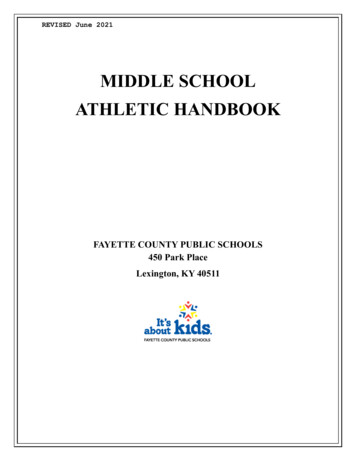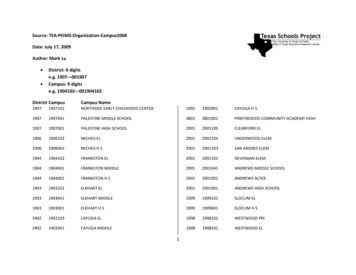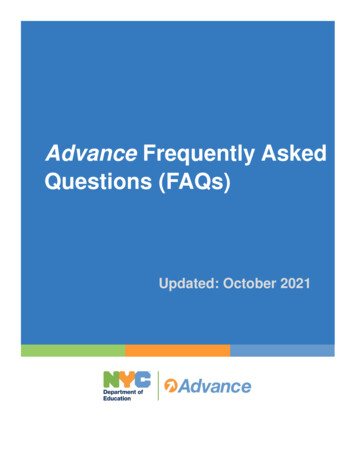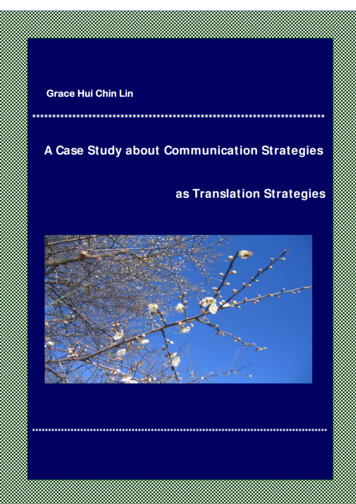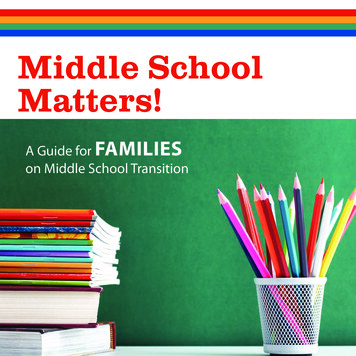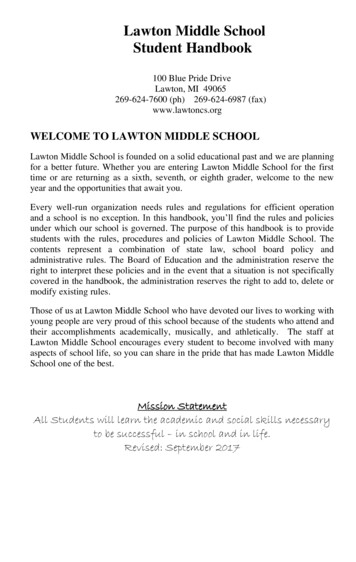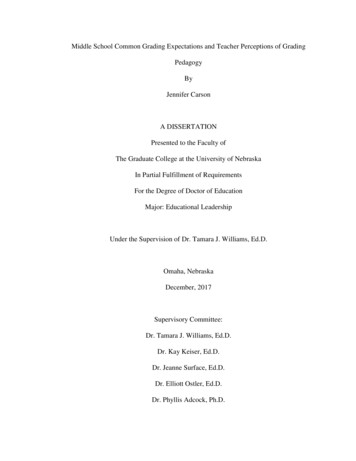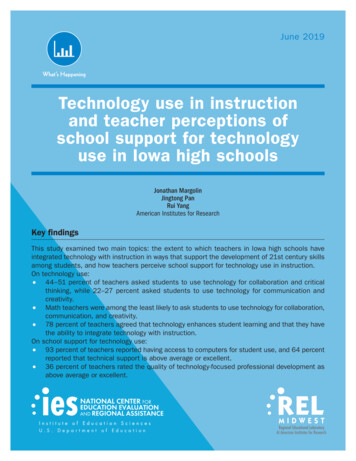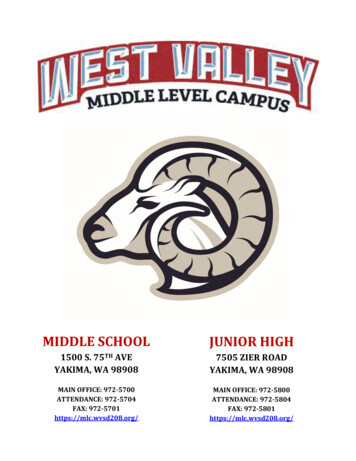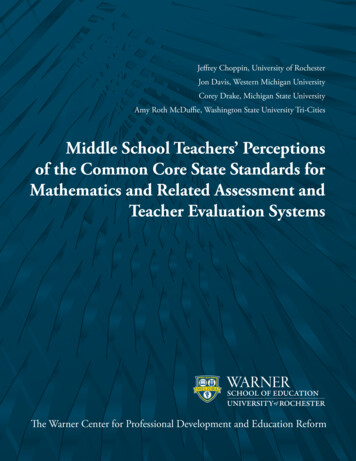
Transcription
Jeffrey Choppin, University of RochesterJon Davis, Western Michigan UniversityCorey Drake, Michigan State UniversityAmy Roth McDuffie, Washington State University Tri-CitiesMiddle School Teachers’ Perceptionsof the Common Core State Standards forMathematics and Related Assessment andTeacher Evaluation SystemsThe Warner Center for Professional Development and Education Reform
Executive SummaryIn April and May 2013, we surveyed the perceptions of 3663. Teachers reported that they were familiar with the CCSSMmiddle school mathematics teachers with regard to theContent Standards and continued to see them as moreCommon Core State Standards for Mathematics (CCSSM)rigorous than their state standards:(Common Core State Standards Initiative, 2010). As of May 93% reported being familiar with the CCSSM Content2013, the CCSSM have been adopted by 45 states, the DistrictStandards.of Columbia, and four U.S. territories and, as a result, constitute 84% agreed or strongly agreed that the CCSSMa U.S. national intended curriculum in mathematics (Porter,Content Standards are more rigorous than their stateMcMaken, Hwang, & Yang, 2010). The main findings of thestandards.survey are presented below:1. A strong majority of teachers agreed that new CCSSM-Implicationsaligned state assessment and evaluation systems willThe overall findings suggest:influence their instructional practices: 92% reported that new state assessments will influencemore conceptually and incorporate more communication,their instructional practices. 91% reported that new state assessments will influencetheir assessment practices. 65% reported that new teacher evaluation systems willinfluence their instructional practices. 64% reported that new teacher evaluation systems willinfluence their assessment practices.Teachers perceived the CCSSM as requiring them to teachproblem solving, and exploration into their teaching. Teachers emphasized the influence of the new CCSSMaligned state assessments and evaluation systems. Therefore,teachers’ efforts to change their teaching in the waysindicated above might only be sustained if the CCSSMbased assessments reflect a similar focus on concepts,communication, problem solving, and exploration. 86% agreed or strongly agreed that there will be anincreased emphasis on student test scores in theevaluation of teachers.2. A strong majority of teachers agreed that their stateassessments will change as a result of adopting theCCSSM: 92% agreed that the new state assessments will bealigned with the CCSSM. 69% agreed or strongly agreed that the assessments willinvolve more difficult numbers. 84% agreed or strongly agreed that the assessments willassess each of the eight mathematical practices. 2013 University of RochesterThis research was supported in part by the National Science Foundation, under grants No. DRL – 746573 and DRL-1222359.The opinions expressed herein are those of the authors and do not necessarily reflect the views of the National Science Foundation.
Middle School Teachers’ Perceptions of the CCSSM andRelated Assessment and Teacher Evaluation SystemsIn 2010, the Common Core State Standards Initiative (CCSSI)all RTTT-funded states and others hoping to be RTTT funded nowreleased the Common Core State Standards (CCSS). The CCSS,include the use of student data from standardized tests in teacherauthored by the National Governors Association Center for Bestevaluations. As of 2012, 20 states use student achievement as anPractices and the Council of Chief State School Officers, areimportant element of teacher evaluations (National Council onintended to “allow our teachers to be better equipped to knowTeacher Quality, 2012). New York State, for example, requires thatexactly what they need to help students learn and establishat least 20% of teacher evaluations come from student growth onindividualized benchmarks for them” (CCSSI, 2010). Since thestate assessments (Regents Task Force on Teacher and Principalrelease of the CCSS, 45 states, the District of Columbia, fourEffectiveness, 2011).territories, and the Department of Defense Education Activity have& Yang, 2010). Analyses of the Common Core State Standards forResults from Other Surveys around Teachers’Perceptions of CCSSM, StandardizedAssessments, and Teacher Evaluation SystemsMathematics (CCSSM) have found that the standards representThere have been a number of surveys conducted over the last twomore rigorous content (Porter et al., 2010) and are more focusedyears related to teachers’ and instructional leaders’ perspectivesand coherent than existing state standards (Schmidt & Houang,on the CCSS, ongoing preparation for the CCSS, development of2012).professional support and aligned curriculum materials, and theadopted the CCSS. Consequently, the CCSS can be viewed asan intended U.S. national curriculum (Porter, McMaken, Hwang,impact of standardized tests on classroom practice and teacherThe current federal educational policy, the Race to the Topevaluation. These surveys are summarized in the following pages.(RTTT) initiative, requires funded states to use standardized testresults to evaluate teachers (Duncan, 2009a; 2009b). As a result,3
The Gates Foundation and Scholastic Inc. conducted an onlinemiddle grades and 60% were in primary grades. An overwhelmingsurvey in 2011 of more than 10,000 teachers (Gates Foundation &majority, (82%), reported familiarity with the CCSSM. Almost allScholastic Inc., 2012). Though the survey did not directly address(94%) liked the idea of the CCSSM, and provided reasons for whythe CCSS, it queried teachers about the role of standardizedthe CCSSM are important: 82% liked the CCSSM for providing atests. The teachers reported that standardized tests influence“consistent, clear understanding of what students were expectedclassroom instruction, with 60% of teachers agreeing thatto learn,” while 81% liked the CCSSM for providing “a high qualitystandardized state tests determine what is taught in classrooms.education to our children.” However, only 40% thought theA majority of respondents agreed that statewide standardizedCCSSM were important for holding “teachers accountable forassessments ensured that students were assessed the same waytheir effectiveness in teaching children the material they needed(69%) and ensured that students were mastering the same skillsto know.” In terms of necessary resources and preparation, 38%and information (52%). However, there was less agreement thatindicated that the lack of textbooks aligned with the CCSSM wouldthe standardized tests could be used as meaningful benchmarksbe a challenge for implementation.for teachers to judge student progress (51%) or to judge schoolsagainst each other (43%). Furthermore, only 26% of teachersReaders of the Education Week online website participated in aagreed that the results of standardized tests are an accuratesurvey in October 2012 conducted by EPE Research (2013). Theirreflection of student achievement and only 45% of teachersresults focused on 599 K-12 teachers or instructional specialistsagreed their students take them seriously. In terms of teacherin states that had adopted the CCSS. They reported similarevaluations, teachers largely agreed that student growth shouldnumbers to the two surveys summarized in this document, withcontribute to measuring their performance (85%), but only78% saying they were familiar with the CCSS and 76% saying the36% agreed that students’ scores on standardized tests shouldCCSS would improve their instruction. The teachers received theircontribute to measurement of their performance.information about the CCSS from a variety of sources, includingschool administrators (60%), state departments of educationMore than 12,000 school district curriculum directors/supervisors(59%), educational media (53%), other teachers (53%), professionaland teachers participated in an online survey between June 8associations (47%), and district publications, including websitesand December 20, 2011 (Cogan, Schmidt, & Houang, 2013). The(43%). In terms of support, a total of 71% said that they hadrespondents were from the 41 states that had adopted the CCSSMreceived training on the CCSS, and of these, 41% had receivedby the latter half of 2011. Of the participating teachers, 20% taughtfour or more days of professional development. Respondents were
moderately confident in the preparedness of their districts, butthey cited a number of factors that would help them feel betterSummary of Previous Survey FindingsLarge majorities of teachers in the surveys reported being familiarprepared, including more planning time (74%), access to alignedwith the CCSS (78% – 82%) (Cogan, Schmidt, & Houang, 2013; EPEcurriculum materials (72%), and aligned assessments (72%). TheyResearch, 2013; Hart Research Associates, 2013) and approvedalso wanted more information about new expectations for studentsof the CCSS (75% - 94%) (Cogan, Schmidt, & Houang, 2013;(67%) and about expected changes to their instructional practicesHart Research Associates, 2013); furthermore, state education(57%). Only 44% of the respondents agreed that their materialsofficials from all 40 responding states felt that the CCSS were morewere aligned with the CCSSM.rigorous than current state standards (Rentner, 2013a). In terms ofpreparation and support, most teachers felt a need for curriculumHart Research Associates (2013) conducted a telephone survey inmaterials better aligned with the CCSSM than their currentMarch 2013, of 800 K-12 teachers who were American Federationmaterials (Cogan, Schmidt, & Houang, 2013; EPE Research, 2013).of Teachers (AFT) members, including 358 secondary teachers (ofRoughly three-quarters of teachers had received some professionalwhom an unknown number were middle school teachers). Similardevelopment, but few had received more than four days ofto the Cogan, Schmidt, and Houang (2013) results, they found thatprofessional development (EPE Research, 2013). Roughly half of the79% of the teachers were very/fairly familiar with the CCSS and 75%teachers in the surveys reported that their districts were preparedapproved of the CCSS. However, the Hart Research Associatesto implement the CCSSM, percentages that dropped for urbansurvey found concerns related to the high-stakes assessmentsand poor schools, and only about a quarter of teachers felt theyassociated with the CCSS. Almost three-quarters of the teachers,had received adequate resources to implement the CCSSM (Hart(73%), worried that the rush to implement new assessments meantResearch Associates, 2013).that “testing and test prep, not teaching and learning, will bethe focus of implementation” (p. 9). A similar number (74%) wereIn terms of the impact of the high-stakes standardized testsworried that the new assessment and accountability systems wouldassociated with the CCSS, considerably less than half of surveyedbe implemented before teachers were able to comprehendteachers (36% – 40%) felt that standardized test scores, includingand align their instructional practices to the standards. In terms ofthose associated with the CCSS, should contribute to teacherpreparation, 57% said their districts were prepared to successfullyaccountability measures (Cogan, Schmidt, & Houang, 2013;implement the CCSS, but these percentages were lower for urbanGates Foundation & Scholastic Inc., 2012), though a large majorityareas and higher for non-urban areas (51%/63%) and lower foragreed that some measure of student growth should contributepoor schools and higher for middle/upper socioeconomic statusto teacher evaluations (Gates Foundation & Scholastic Inc., 2012).schools (50%/64%). Only 27% of respondents reported havingIn terms of impact on instruction, a majority of teachers (60%)received tools and resources to teach the CCSS, and only 43%indicated that the content of standardized tests would impactreported having received adequate training.what they teach (Gates Foundation & Scholastic Inc., 2012), andeven larger numbers (73%) agreed that such tests, particularlyState officials in 40 states that had adopted the CCSS werethose implemented rapidly, would focus instruction on testing andsurveyed by the Center for Educational Progress (CEP) in springtest preparation, especially if teachers do not have adequate time2013 about their perceptions of the CCSS and their efforts toto understand the standards (Hart Research Associates, 2013).prepare for the CCSS. Officials from all 40 responding statesreported that the CCSS were more rigorous than their current stateGiven the changes the CCSSM represent for most states in terms ofstandards (Rentner, 2013a). Furthermore, officials from 30 of the 40the mathematical content, the incorporation of the CCSSM in statestates reported that they were using curricula aligned to the CCSSassessments, and the use of standardized student achievementin some of their grade levels. Most state officials stated it woulddata in teacher evaluations, this is a particularly challengingbe challenging to identify or develop curriculum materials for thetime for teachers and districts. Consequently, it is important tostandards and that they were having difficulty finding resources tounderstand how teachers perceive the CCSSM, the CCSSM-relateddevelop accountability and evaluation systems. In a second reportassessments, and the teacher evaluation processes linked to theon the same survey (Kober, McIntosh, & Rentner, 2013), officialsCCSSM. Middle school teachers are an important group to studyfrom 22 of the 40 states estimated that 50% of their teachersbecause they typically hold certifications to teach secondaryhad participated in CCSS-related professional developmentmathematics, teach only mathematics (especially 7th and 8thand officials from 10 states said that 75% of their teachers hadgrade teachers), and are in the NCLB- and RTTT- grades bands forparticipated in CCSS-related professional development. In a thirdmandatory achievement tests.report on the same survey, officials from 11 states reported alreadyembedding CCSS-related items in their state assessments or havingremoved items not aligned to the CCSS (Rentner, 2013b).5
MethodsSurvey questions involving Likert scale items as well as open-endedtheir planning. We sorted these resources into different categoriesresponses were developed to examine primary and secondarybased upon their location (e.g., online). For each of the open-issues related to the CCSSM. Issues included teachers’ perceptionsended response items, some teachers supplied unclear responseswith regard to the CCSSM and comparisons between their pastthat we were unable to categorize. Those responses were notstate frameworks and the CCSSM, teachers’ planning practices,included in the analyses reported in the following pages.curriculum documents used for planning, teachers’ perceptions ofnew state assessments, and teachers’ perceptions of new teacherevaluation systems.SampleThe survey was administered to middle school teachers nationwideby Market Data Retrieval (MDR) during late April and early May2013. There were two primary sampling sources. The first samplesource was MDR’s online educator panel, which consists of teacherswho agreed to participate in MDR survey research. The secondTable 1Teachers th8721108Eighth10833141Total28086366source was MDR’s client e-mail sample of educators. The secondarysource was used to improve the representation of middle schoolmathematics teachers in the sample. Survey invitations wererandomized nationally based upon state. Private and parochialChanges from Survey 1 to Survey 2schools were excluded from the process. The order of questions wasThis survey builds from an earlier survey, which we will referrandomized during each administration of the survey.to as Survey 1, that was reported in a previous report (Davis,Choppin, Roth McDuffie, & Drake, 2013). Survey 2, reportedA total of 366 middle school teachers working in 42 of the 45here, had approximately the same number of participants andCCSSM-adopting states were surveyed. The demographicsused similar methods. Survey 1, which had 403 middle schoolassociated with these teachers are shown in Table 1. Overall, thereteacher respondents, was administered in February 2013, whilewere more teachers whose primary teaching responsibility wasSurvey 2, which had 366 middle school teacher respondents, waseighth grade, and a strong majority of the sample was female.administered in late April and early May. We conducted twoPrevious research has shown that 84% of public school teacherssurveys to allow us to refine our questions, to delete questionsin the United States are female and 16% of this same group ofthat were not useful, and to add questions based on our ongoingteachers is male (Feistritzer, 2011). Thus, the percentages in ouranalysis of the data and emerging issues related to the CCSSM.sample of 77% for female teachers and 23% for male teachers aresimilar to these national figures.AnalysisEleven items carried over from Survey 1 to Survey 2, as listed inAppendix A. We deleted 17 items from Survey 1 based on theircorrelation, or lack of correlation, with other items and to provideThe data analyses involving Likert-type questions consisted ofspace to add new items in Survey 2. We also revised 11 itemsthe enumeration of different categories and the calculation ofin Survey 2, as listed in Appendix B. In some cases, we revisedpercentages. Open-ended questions were broken down intothe wording of the question and, in other cases, we revised thecategories in a variety of different ways. For instance, participantsresponse choices. The revision in response choices was donewere asked to identify other types of resources that they used into minimize variation in response choices, which simplified the
formatting of the survey and allowed for greater randomizationof items within each set of response choices. We added 17Comparing Results Across SurveysFor the items that appeared in both surveys and for the items fornew items in Survey 2, around teachers’ perceptions of the newwhich revisions were minimal, we compared the percentages ofstate assessments and new evaluation systems and around theresponses in the respective categories. For example, we comparedcurriculum documents teachers refer to when they plan instruction,the percentage who “agreed” in Survey 1 to the percentageas displayed in Appendix C. We added these items because ofwho “agreed” in Survey 2. In many cases, we also combinedthemes we noticed in interviews conducted as part of a largercategories that expressed the same sentiment, but differed byongoing study around teachers’ understanding and use ofdegree of strength. For example, we combined “a little more thancurriculum materials with respect to the CCSSM (Choppin, Davis,before” and “a lot more than before” and we combined “agree”Drake, & Roth McDuffie, 2012).and “strongly agree” in order to generate overall percentages ofteachers who reported greater use of a resource or who agreedwith a statement. In the summary of results in the following pages,we mostly report the combined percentages and sometimes thepercentage of the most extreme category when there were a highnumber of respondents in that category.7
ResultsFirst, we compare the results from questions that were identical orsimilar across Survey 1 and Survey 2. Second, we report the resultsTable 2Results Reported for Survey 1 and Survey 2of questions included only in Survey 2.ItemsSurvey 1Survey 2Familiarity with ContentStandards87.1% moderatelyor extensively92.7% moderatelyor extensivelyFamiliarity with PracticeStandards87.1% moderatelyor extensively83.3% moderatelyor extensivelyDistricts encouraged teachers totry new instructional approaches77.8% moderatelyor extensively79.5% moderatelyor extensivelyDistricts provided opportunitiesto learn about the CCSSM71.5% moderatelyor extensively74% moderately orextensivelyCCSSM emphasize mathematicalcommunication94.4% moderatelyor extensively91% moderately orextensivelyThe CCSSM will require you tocommunicate with your studentsNA84.7% agreed orstrongly agreedpages.The CCSSM emphasize thesolving of complex problems88.1% moderatelyor extensively94.5% moderatelyor extensivelyFamiliarity. The Survey 2 sample reported slightly more familiarityThe CCSSM will incorporatemore student exploration83.2% more thanbefore or a lot morethan before84.9% agreed orstrongly agreedCCSSM will emphasize activitiesin which students explore topicsNA86.7% agreed orstrongly agreedCCSSM represent new contentfor their grade level60.5% moderatelyor extensively63.5% agreed orstrongly agreedThe Content Standards are morerigorous than your state standards85.3% agreed orstrongly agreed84.4% agreed orstrongly agreed83.3% in Survey 2).The Practice Standards are morerigorous than your state standards86.9% agreed orstrongly agreed84.7% agreed orstrongly agreed44.6% more thanbefore or a lot morethan beforeNADistrict support for teachers. Approximately the same percentageCCSSM would require youto teach for procedural orcomputational fluencyThe CCSSM will require you toteach more procedurallyNA41.6% agreed orstrongly agreedThe CCSSM would require you toteach more conceptually79.2% more thanbefore or a lot morethan beforeNAThe CCSSM will require you toteach conceptuallyNA85% agreed orstrongly agreedResults from Questions Identical or Similar toThose in Survey 1The results from Survey 1 and Survey 2 provided similar outcomesfor (1) familiarity with the standards, (2) level of district supportfor teachers, (3) nature and rigor of the CCSSM, (4) impact onteaching, and (5) planning practices. There were some differencesin Survey 2 sample’s reported use of electronic resources, withSurvey 2 respondents reporting less extensive uses of electronicresources. These results are explored in more detail in the followingthan the Survey 1 sample with the CCSSM Content Standards, with92.7% reporting that they were modestly or extensively familiar(vs. 87.1% in Survey 1). Moreover, 40%, compared to 30% in Survey1, indicated that they were extensively familiar with the CCSSMContent Standards. A slightly lower percentage of the Survey 2respondents reported being moderately or extensively familiarwith the Standards for Mathematical Practice (87.1% in Survey 1 vs.of teachers (77.8% in Survey 1 vs. 79.5% in Survey 2) agreed thattheir district moderately or extensively had encouraged them to trynew instructional approaches, and that their district moderately orextensively had provided opportunities to learn about the CCSSM(71.5% in Survey 1 vs. 74% in Survey 2).Teachers’ perceptions of the CCSSM. Teachers’ perceptionsof the CCSSM in the Survey 2 sample seemed relatively similaragreeing. There was a slight increase in the number of teachersto the Survey 1 sample. A strong majority agreed that thewho stated that the CCSSM moderately or extensively emphasizeCCSSM moderately or extensively emphasize mathematicalthe solving of complex problems (88.1% in Survey 1 vs. 94.5% incommunication (94.4% in Survey 1 vs. 91% in Survey 2).We asked aSurvey 2). In a question that was revised for Survey 2, 86.7% ofnew, but similar question in Survey 2, “the CCSSM will require you toteachers agreed that the CCSSM “emphasize activities in whichcommunicate with your students,” with 84.7% agreeing or stronglystudents explore topics” and 84.9% agreed that the CCSSM will
“incorporate more student exploration,” consistent with the Survey1 question, in which 83.2% responded that the CCSSM will “moreTable 3Planning Practices Reported in Survey ly study equently 0.9%)Regularly plan than before” incorporate more student exploration.Most teachers reported that the CCSSM represent new contentfor their grade level. In Survey 1, a majority of teachers (60.5%)reported that the CCSSM moderately or extensively represented“new content for the indicated grade level,” while in Survey 2,63.5% agreed or strongly agreed with the same statement.There was agreement across the two samples in terms of the rigorof the CCSSM, with 84.4% agreeing that the Content StandardsIn terms of teachers’ use of electronic resources, the Survey 2were more rigorous than their state standards (vs. 85.3% in Surveysample reported lower rates of daily or weekly use compared1) and 84.7% agreeing that the Practice Standards were moreto the Survey 1 sample for “practice or remediation” (61.6% inrigorous than their state standards (vs. 86.9% in Survey 1).Survey 1 vs. 46.3% in Survey 2), lower rates for “student text pagesor worksheets” in terms of daily or weekly use (62.6% in SurveyImpact on teaching. In terms of the influence of the CCSSM1 vs. 44.3% in Survey 2), slightly lower daily or weekly rates foron teaching, we modified the questions in Survey 2. In Survey“supplementary materials” (64.3% in Survey 1 vs. 58.3% in Survey 2),1, we asked teachers if the CCSSM required them to teach forand lower rates for “supplemental inquiry-based activities” (51.6%“procedural or computational fluency” with response choicesin Survey 1 vs. 39.3% in Survey 2). We changed the second columnincluding “less than before,” “about the same as before,” “aof the response choices to “occasionally” from “very rarely,” whichlittle more than before,” and “a lot more than before.” In Surveymay have altered responses in and around that category.2, we asked teachers if the CCSSM required them “to teachmore procedurally,” with answer choices of “strongly disagree,”“disagree,” “agree,” and “strongly agree.” In Survey 1, 44.6%responded that the CCSSM would require them to teach forprocedural or computational fluency “a little more than before”Table 4Frequency of Teachers’ Engagement with Digital/ElectronicMaterials Reported in Survey 2None at allOccasionallyOnce ortwice amonthOnce ortwice aweekAlmosteverydayPractice 4(23%)Student text pagesor ties44(12%)87(23.8%)91(24.9%)82(22.4%)62(16.9%)or “a lot more than before.” In Survey 2, 41.6% of the teachersagreed or strongly agreed that the CCSSM will require them toteach more procedurally. Of the 152 teachers who agreed orstrongly agreed that the CCSSM would require them to teach moreprocedurally, 144 (94.7%) of them also agreed or strongly agreedthat the CCSSM would require them to teach more conceptually.We revised the answer choices for the question about whetherthe CCSSM required teachers to teach more conceptually similarto the question above. In Survey 1, 79.2% of the teachers reportedthat the CCSSM would require them to teach more conceptually“a little more than before” or “a lot more than before,” of which42.1% reported “a lot more than before.” In Survey 2, 85% agreedor strongly agreed that the CCSSM will require them to teachconceptually, with 30.1% strongly agreeing.Planning practices with colleagues. In terms of planning practices,considerably more teachers in Survey 2 agreed that they regularlystudy student work with colleagues (45.4% in Survey 1 vs. 64.2% inSurvey 2). We also found differences between the surveys in termsof the number of teachers who agreed that they frequently discussmathematics with colleagues (76.9% in Survey 1 vs. 84.5% in Survey2) and who agreed that they regularly plan with colleagues (56.3%in Survey 1 vs. 65.3% in Survey 2). In Table 3, we report the results forQuestions Unique to Survey 2: Teachers’Perceptions of the CCSSM Assessments andTeacher EvaluationWe added questions to Survey 2 to explore teachers’ perceptionsof the CCSSM-related state assessments and changes to teacherevaluation systems that coincided with the adoption of theCCSSM. As noted earlier, we added these items because ofthemes we noticed in interviews conducted as part of a largerongoing study around teachers’ understanding and use ofcurriculum materials with respect to the CCSSM (Choppin, Davis,Drake, & Roth McDuffie, 2012).Survey 2. Similarly, detailed results for Survey 1 are presented in ourprior report (Davis, Choppin, Roth McDuffie, & Drake, 2013).9
Perspectives on New State AssessmentsPerspectives on Teacher EvaluationsThe teachers were asked to compare the new state assessments toThe increased use of standardized student test scores in teachertheir state assessments in place prior to the adoption of the CCSSM.evaluations represents a significant change for most teachers.The new assessments had not been implemented, so in effect weWhen asked whether there was going to be an increasedwere asking teachers to express their agreement about what theemphasis on student scores in teacher evaluations, 85.5% ofnew state assessments will be like when they are implemented.the teachers agreed or strongly agreed that was the case, asThe teachers in the sample were anticipating a high degree ofseen in Table 6. Furthermore, a majority of teachers agreed oralignment between new state assessments and the CCSSM, withstrongly agreed that the evaluation process would influence their91.2% agreeing or strongly agreeing that the new test will beinstructional decisions (65.1%) and their assessment practicesaligned with the CCSSM Content Standards (see Table 5). They(54.2%).also anticipated the new assessments would have more difficultnumbers in the problems (68.9% agreeing or strongly agreeing) andwould separately assess each of the eight mathematical practicesTable 6Teacher Evaluations(83.8% agreeing or strongly agreeing).In terms of impact on teachers’ practices, large majorities agreedor strongly agreed that the new state assessments will influencetheir instructional decisions (92%) and their assessment p
Common Core State Standards for Mathematics (CCSSM) (Common Core State Standards Initiative, 2010). As of May 2013, the CCSSM have been adopted by 45 states, the District of Columbia, and four U.S. territories and, as a result, constitute a U.S. national intended curriculum in mathematics (Porter, McMaken, Hwang, & Yang, 2010).
